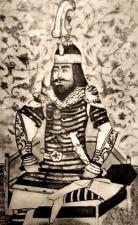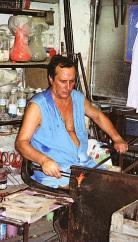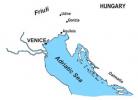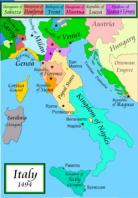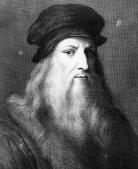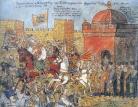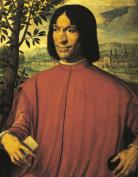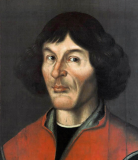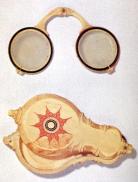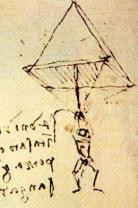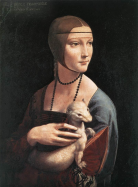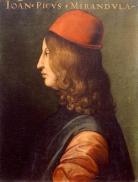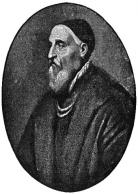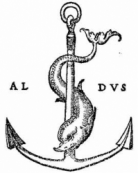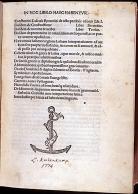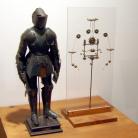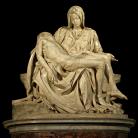Making the Human/ Inventing Venice
Created by Dino Franco Felluga on Fri, 12/30/2016 - 10:56
Part of Group:
This timeline allows students to see important events connected to the transition from Medieval to Renaissance Italy (focussed especially on Venice).
Timeline
Chronological table
| Date | Event | Created by | Associated Places | |
|---|---|---|---|---|
| circa. 1396 to circa. 1470 |
Life of Jacopo BelliniLife of Jacopo Bellini, father of Gentile and Giovanni Bellini and father-in-law of Andrea Mantegna. Image: Jacopo Bellini, Madonna and Child, c. 1465 (Los Angeles County Museum of Art). This file is in the public domain because it has been released by the Los Angeles County Museum of Art with its "Public Domain High Resolution Image Available" mark. |
Dino Franco Felluga | ||
| 1397 |
Medici's Move to FlorenceWhile many of us know about the Medici family, it is important to look at the very beginning of this family's success in Italy in order to understand the rest of their history. Giovanni de Medici moved from Rome to Florence in 1397 to establish another branch of the Medici Bank. There were already many branches of the Medici Bank not only all over Italy, but also all over Europe. Thus, Giovanni was already a very successful man, giving the Medici name a solid foundation for its future endevours. Given this information, one can see how the Medici family was set up for success in the textile indusrty and the world of international finance starting in the 1420s. |
Mara Kossoff | ||
| circa. 1400 |
Trend of PatronagePatronage, derived from the Latin word for father, illustrates a trend that began in Renaissance Italy where rich merchant families became patrons (sponsors) of people that showed gifted talents in areas such as the sciences, music, and art. Being a patron meant supplying the gifted individuals with money, accomodations, and various materials. Providing these gifted individuals with such resources allowed them to dedicate all of their energy to their respective field. |
Mara Kossoff | ||
| circa. 1400 |
Popularity of PatronageAfter the word spread about the wealthy patrons in Italy, many artists, inventors, and those of the like with excellent talent, started traveling to Italy from other parts of Europe in hopes of being sponsored by one of these patrons. A competition between the wealthy patrons of different families soon began: Who could commission the greatest books, inventions, artworks, or inventions. While these patrons commissioned these talented artists and inventors in order to bring their city great repute, the families also wanted to be remembered in history as having the greatest talent under their commission. |
Mara Kossoff | ||
| 1400 |
Destruction of DamascusThe Mongolians, led by Timur the Great, destroyed Damascus (in today's Syria) in 1400. At the time, Damascus was a rival city to Venice with regard to glass production. When the city's infrastructure was demolished, the glassmakers of Demascus, in order to continue their trade with the best tools, fled to Venice. The glass industry in Venice was already growing rapidly, but this influx of artists contributed to Venice's achieving its glass glory in the late 15th century. The photo of Timur the Great is Public Domain according to Wikipedia. |
Barbara McAnulty | ||
| circa. 1400 to circa. 1500 |
Shift from Tempera Paints to Oil Paints Madonna and Child by Giovanni Bellini. The left portrait was painted in 1462 with tempera and the right was painted in 1488 with oil. |
Kate Harris | ||
| 1409 |
First Experiments with CristalloCristallo is a clear, hard, malleable glass that revolutionized glass as it become popular technology in the 15th century. The photo is a glassmaker in Murano. According to Wikipedia, the picture is Public Domain. |
Barbara McAnulty | ||
| 1414 to 1418 |
Council of Constance resolves Western SchismIn 1414, the Council of Constance convened with the intention of resolving the Western Schism that arose amidst conflict surrounding the legitimacy of papal claimants from several defector territories. King Sigismund of Germany led deliberations of the council, and made a failed attempt to ensure the abdication of the three rival claimants. After Gregory XII sent delegates to Constance, whom he endowed with the power to preside over the council, King Sigismund yielded his presidency to the delegates, who then offered the resignation of Gregory XII to the papacy. This gesture by the Roman papal claimant paved the way for détente within Western Europe as the election of a single legitimate pope, Pope Martin V, meant that the papacy once again had roots firmly planted in Rome. (Image Source: Unknown [Public Domain], via Wikimedia Commons, https://commons.wikimedia.org/w/index.php?curid=507475) |
Andrew Natoli | ||
| 1418 to 1420 |
Friuli placed under Venetian controlVenice acquired Friuli from 1418-1420 as a result of tensions with the King of Hungary, who had gained control of Dalmatia. In 1420, the Venetians succeeded against the Patriarch of Aquileia, thus wresting control of Udine (and doubling her mainland territory). In the same year, Venice reasserted her control of Dalmatia. |
Dino Franco Felluga | ||
| 1424 to 1453 |
Fall of ConstantinopleEventual Ottoman victory over the Byzantine Greeks, culminating in the fall of Constantinople (now Istanbul). All Venetian outposts in the eastern Mediterranean were suddenly at risk. |
Dino Franco Felluga | ||
| 1425 to 1454 |
Wars in Lombardy:The wars in Lombardy were a series of struggles between the Republic of Venice and the Duchy of Milan, leading to the five major Italian territorial powers that make up the map of Italy until the Italian Wars (i.e., Venice, Milan, Florence, Naples, and the Papacy). The wars ravaged the economy of Lombardy and weakened the power of Venice. The Peace of Lodi in 1454 brought 40 years of comparative peace to Northern Italy. This is the time of the Medici rule of Florence, first Cosimo de’ Medici, then Piero “the Gouty,” then Lorenzo Il Magnifico. The death of Lorenzo marked the end of the Golden Age of Renaissance Florence. Both Leonardo da Vinci and Michelangelo Buonarroti were active (and tied to Lorenzo) during this period. In 1428, Venice acquired Brescia and Bergamo as a result of this struggle. |
Dino Franco Felluga | ||
| Jan 1428 |
Joan of Arc's VictoryJoan of Arc's first major military victory was the Siege of Orleans that took place from 1428-1429. The Siege of Orleans was a very important event in history. The Siege of Orleans signaled a turning point in the Hundred Years' War between France and England. This was the first major French success after their defeat at Agincourt in 1415. |
Mara Kossoff | ||
| 1439 |
Gutenberg's Printing ShopThe printing press was developed by Johannes Gutenberg and printed the Gutenberg Bible completed in 1454. The printing press was a major first step in developing a widespread database that has led to the Internet today. Mass communication was made possible and is significant in allowing the spread of ideas in a way that was previously impossible and inaccessible to those not in a clerical position. Print also cultivated the idea of authorship, which would have been foreign to a pre-renaissance society. |
Hannah Mylin | ||
| 1440 to 1504 |
Life of Mauro CodussiMauro Codussi was a famous Venetian Gothic architect who is famous for designing many churches and palaces. These works include the church of San Michele in Isola, the interior of the church of Santa Maria Formosa, and the staircase of San Giovanni Evangelista. Evidence suggests that he designed the structure of St. Mark's Clock Tower. For example, the decorations of the tower are less important to the Tower itself, which is a common trait for Codussi's works. This is an image of San Michele in Isola. Image by Paolo Monti [CC BY-SA 4.0 (http://creativecommons.org/licenses/by-sa/4.0)], via Wikimedia Commons |
Mikaela Meyer | ||
| 1449 to 6 Feb 1515 |
Aldus ManutiusAldus Manutius was born in the papal state of Bassiano in 1449 and died on February 6, 1515. Manutius would found the Aldine Press in 1494 and establish a reputation as a printer, publisher, and typographer based in Venice. After his death in 1515, his brother – in – law and third son would continue to operate the press. This image was sourced from Wikimedia Commons and is public domain. |
Laura Titzer | ||
| 1450 |
Gutenberg Printing Press1) Johannes Gutenberg got the final design of the printing press working in 1450. His first project was printing indulgences that the Church used, In 1451 he used the printing press to produce copies of the Bible, resulting in the famous Gutenberg Bible. Success of the printing press came from increased literacy rates. His printing press was used throughout Europe in the following years. This information came from Oregon State. This photo is from Wikimedia Commons and is free to share. |
Nathaniel Gollmer | ||
| 15 Apr 1452 |
Leonardo da VinciLeonardo da Vinci was born April 15, 1452 in Vinci, Italy. As a child he did not have any special formal education, but when he was a teenager his father recognized his artistic talent and arranged for him to be trained under the famous artist Andrea del Verrochio from Florence. From this apprenticeship he was introduced to many technical skills such as metal working, as well as improving his painting and sculpting techniques. Since he was a scientist, artist, and inventor among many other things, his knowledge of many disciplines gave him the title of a Renaissance Man. His most famous paintings are the Mona Lisa and The Last Supper, and he is also recognized for his study of human anatomy and his many inventions. He died at 67 in the year 1519. Image source: Wikimedia commons, listed as public domain in the United States because it is a photographic reproduction of a public domain work of art. |
Juliana Ilmain | ||
| 1453 |
Fall of ConstantinopleThe fall of Constantinople in 1453 to the Ottoman Empire effectively ended the Middle Ages and signaled the beginnings of the Renaissance. Greek scholars fled the city with manuscripts and knowledge unheard of in the West. The fall of Constantinople also broke trade routes between Europe and Asia, which led to exploration for new routes to Asia and the “Age of Exploration.” This image is sourced from Wikimedia Commons and is public domain. |
Laura Titzer | ||
| 1454 |
Gutenberg Bible PublishedThe Gutenberg Bible was one of the first books to be printed and produced in Europe. The book was copied using a movable metal type and spurred the Gutenberg Revolution, also known as the age of print in the West. The bible was written in Latin, the vernacular of the Roman Catholic Church and was very beautiful. The pages were artfully made and the text was a gorgeous font. This was the first time that people other than the upper class and aristocrats could have access to the written word. People could purchase a bible to have in their own homes rather than skimming through one in a library. The orignals were rather expensive though, so it's beleived that most were sold to monasteries or universities. Image source: https://www.loc.gov/exhibits/bibles/the-gutenberg-bible.html |
Caroline Brown | ||
| 1460 |
Construction of Porta di TerraIn 1460, the Arsenal of Venice had its gate completed. The gate is known as the Porta di Terra, and it was the first structure in Venice to use classical style architecture, moving away from the Gothic architecture that had dominated the city. The Porta di Terra even includes statues of the Roman Pantheon, which is rather curious considering Christianity was the dominant religion in Venice at that moment in time. Later in 1572, a lion was added to the top to commerate the Venetian victory in the Battle of Lepanto. Source: The Porta di Terra. (n.d.). Retrieved February 09, 2017, from http://arsenalofvenice.weebly.com/the-porta-di-terra.html. This file is made available under the Creative Commons CC0 1.0 Universal Public Domain Dedication. |
Jacob Hussey | ||
| 1469 |
Lorenzo de MediciLorenzo de Medici, the grandson of Cosimo de Medici, came to power in 1469. Lorenzo is thought of as the most powerful patron of the Medici family and is remembered as the greatest patron in the history of Italy. Some of the talent Lorenzo sponsored as a patron includes Michelangelo Buonarroti and Leonardo da Vinci, two of the most famous people in history. Under Lorenzo's rule, Florence earned its reputation as the most beautiful city in Europe. Additionally, the economy of Florence prospered like never before. |
Mara Kossoff | ||
| 9 Aug 1471 to 12 Aug 1484 |
Sixtus IV Reigns as PopeAs Pope Sixtus IV (born Francesco della Rovere) began his papal reign, he made clear his intention to renew the crusade against the Ottoman Turks. Despite initial successes by Pope Sixtus IV in such religiously-motivated efforts as the military expeditions against the Turks in Smyrna, his attempts at evangelism in Turkic territory and at unification of the Church in Europe failed entirely. Thus, throughout the majority of his reign, Pope Sixtus IV invested in cultural and political ventures that would help to strengthen his position as Pope. He surrounded himself with relatives and friends, building on the prestige of his familial line through nepotistic practices, while involving himself in a number of scandalous practices. From endorsing his nephews’ plot to overthrow the Medici, to inciting Venetian aggression against the duchy of Ferrara, Pope Sixtus IV paved a path of corruption that would consume the reign of future popes. (Image Source: Melozzo da Forlì [Public Domain], via Wikimedia Commons, https://commons.wikimedia.org/w/index.php?curid=155449) |
Andrew Natoli | ||
| 1473 to 1543 |
Nicolaus Copernicus96 Normal 0 false false false EN-US X-NONE X-NONE DefSemiHidden="false" DefQFormat="false" DefPriority="99" LatentStyleCount="380"> UnhideWhenUsed="true" QFormat="true" Name="heading 2"/> UnhideWhenUsed="true" QFormat="true" Name="heading 3"/> UnhideWhenUsed="true" QFormat="true" Name="heading 4"/> UnhideWhenUsed="true" QFormat="true" Name="heading 5"/> UnhideWhenUsed="true" QFormat="true" Name="heading 6"/> UnhideWhenUsed="true" QFormat="true" Name="heading 7"/> UnhideWhenUsed="true" QFormat="true" Name="heading 8"/> UnhideWhenUsed="true" QFormat="true" Name="heading 9"/> Name="index 1"/> Name="index 2"/> Name="index 3"/> Name="index 4"/> Name="index 5"/> Name="index 6"/> Name="index 7"/> Name="index 8"/> Name="index 9"/> UnhideWhenUsed="true" Name="toc 1"/> UnhideWhenUsed="true" Name="toc 2"/> UnhideWhenUsed="true" Name="toc 3"/> UnhideWhenUsed="true" Name="toc 4"/> UnhideWhenUsed="true" Name="toc 5"/> UnhideWhenUsed="true" Name="toc 6"/> UnhideWhenUsed="true" Name="toc 7"/> UnhideWhenUsed="true" Name="toc 8"/> UnhideWhenUsed="true" Name="toc 9"/> Name="Normal Indent"/> Name="footnote text"/> Name="annotation text"/> Name="header"/> Name="footer"/> Name="index heading"/> UnhideWhenUsed="true" QFormat="true" Name="caption"/> Name="table of figures"/> Name="envelope address"/> Name="envelope return"/> Name="footnote reference"/> Name="annotation reference"/> Name="line number"/> Name="page number"/> Name="endnote reference"/> Name="endnote text"/> Name="table of authorities"/> Name="macro"/> Name="toa heading"/> Name="List"/> Name="List Bullet"/> Name="List Number"/> Name="List 2"/> Name="List 3"/> Name="List 4"/> Name="List 5"/> Name="List Bullet 2"/> Name="List Bullet 3"/> Name="List Bullet 4"/> Name="List Bullet 5"/> Name="List Number 2"/> Name="List Number 3"/> Name="List Number 4"/> Name="List Number 5"/> Name="Closing"/> Name="Signature"/> UnhideWhenUsed="true" Name="Default Paragraph Font"/> Name="Body Text"/> Name="Body Text Indent"/> Name="List Continue"/> Name="List Continue 2"/> Name="List Continue 3"/> Name="List Continue 4"/> Name="List Continue 5"/> Name="Message Header"/> Name="Salutation"/> Name="Date"/> Name="Body Text First Indent"/> Name="Body Text First Indent 2"/> Name="Note Heading"/> Name="Body Text 2"/> Name="Body Text 3"/> Name="Body Text Indent 2"/> Name="Body Text Indent 3"/> Name="Block Text"/> Name="Hyperlink"/> Name="FollowedHyperlink"/> Name="Document Map"/> Name="Plain Text"/> Name="E-mail Signature"/> Name="HTML Top of Form"/> Name="HTML Bottom of Form"/> Name="Normal (Web)"/> Name="HTML Acronym"/> Name="HTML Address"/> Name="HTML Cite"/> Name="HTML Code"/> Name="HTML Definition"/> Name="HTML Keyboard"/> Name="HTML Preformatted"/> Name="HTML Sample"/> Name="HTML Typewriter"/> Name="HTML Variable"/> Name="Normal Table"/> Name="annotation subject"/> Name="No List"/> Name="Outline List 1"/> Name="Outline List 2"/> Name="Outline List 3"/> Name="Table Simple 1"/> Name="Table Simple 2"/> Name="Table Simple 3"/> Name="Table Classic 1"/> Name="Table Classic 2"/> Name="Table Classic 3"/> Name="Table Classic 4"/> Name="Table Colorful 1"/> Name="Table Colorful 2"/> Name="Table Colorful 3"/> Name="Table Columns 1"/> Name="Table Columns 2"/> Name="Table Columns 3"/> Name="Table Columns 4"/> Name="Table Columns 5"/> Name="Table Grid 1"/> Name="Table Grid 2"/> Name="Table Grid 3"/> Name="Table Grid 4"/> Name="Table Grid 5"/> Name="Table Grid 6"/> Name="Table Grid 7"/> Name="Table Grid 8"/> Name="Table List 1"/> Name="Table List 2"/> Name="Table List 3"/> Name="Table List 4"/> Name="Table List 5"/> Name="Table List 6"/> Name="Table List 7"/> Name="Table List 8"/> Name="Table 3D effects 1"/> Name="Table 3D effects 2"/> Name="Table 3D effects 3"/> Name="Table Contemporary"/> Name="Table Elegant"/> Name="Table Professional"/> Name="Table Subtle 1"/> Name="Table Subtle 2"/> Name="Table Web 1"/> Name="Table Web 2"/> Name="Table Web 3"/> Name="Balloon Text"/> Name="Table Theme"/> Name="Note Level 1"/> Name="Note Level 2"/> Name="Note Level 3"/> Name="Note Level 4"/> Name="Note Level 5"/> Name="Note Level 6"/> Name="Note Level 7"/> Name="Note Level 8"/> Name="Note Level 9"/> Name="List Paragraph"/> Name="Intense Quote"/> Name="Subtle Emphasis"/> Name="Intense Emphasis"/> Name="Subtle Reference"/> Name="Intense Reference"/> UnhideWhenUsed="true" Name="Bibliography"/> UnhideWhenUsed="true" QFormat="true" Name="TOC Heading"/> Name="Grid Table 1 Light Accent 1"/> Name="Grid Table 6 Colorful Accent 1"/> Name="Grid Table 7 Colorful Accent 1"/> Name="Grid Table 1 Light Accent 2"/> Name="Grid Table 6 Colorful Accent 2"/> Name="Grid Table 7 Colorful Accent 2"/> Name="Grid Table 1 Light Accent 3"/> Name="Grid Table 6 Colorful Accent 3"/> Name="Grid Table 7 Colorful Accent 3"/> Name="Grid Table 1 Light Accent 4"/> Name="Grid Table 6 Colorful Accent 4"/> Name="Grid Table 7 Colorful Accent 4"/> Name="Grid Table 1 Light Accent 5"/> Name="Grid Table 6 Colorful Accent 5"/> Name="Grid Table 7 Colorful Accent 5"/> Name="Grid Table 1 Light Accent 6"/> Name="Grid Table 6 Colorful Accent 6"/> Name="Grid Table 7 Colorful Accent 6"/> Name="List Table 1 Light Accent 1"/> Name="List Table 6 Colorful Accent 1"/> Name="List Table 7 Colorful Accent 1"/> Name="List Table 1 Light Accent 2"/> Name="List Table 6 Colorful Accent 2"/> Name="List Table 7 Colorful Accent 2"/> Name="List Table 1 Light Accent 3"/> Name="List Table 6 Colorful Accent 3"/> Name="List Table 7 Colorful Accent 3"/> Name="List Table 1 Light Accent 4"/> Name="List Table 6 Colorful Accent 4"/> Name="List Table 7 Colorful Accent 4"/> Name="List Table 1 Light Accent 5"/> Name="List Table 6 Colorful Accent 5"/> Name="List Table 7 Colorful Accent 5"/> Name="List Table 1 Light Accent 6"/> Name="List Table 6 Colorful Accent 6"/> Name="List Table 7 Colorful Accent 6"/> /* Style Definitions */ table.MsoNormalTable {mso-style-name:"Table Normal"; mso-tstyle-rowband-size:0; mso-tstyle-colband-size:0; mso-style-noshow:yes; mso-style-priority:99; mso-style-parent:""; mso-padding-alt:0in 5.4pt 0in 5.4pt; mso-para-margin:0in; mso-para-margin-bottom:.0001pt; mso-pagination:widow-orphan; font-size:12.0pt; font-family:Calibri; mso-ascii-font-family:Calibri; mso-ascii-theme-font:minor-latin; mso-hansi-font-family:Calibri; mso-hansi-theme-font:minor-latin;} By the time Copernicus was studying at the University of Padua (between 1501 and 1503) he had already made a series of observations and been highly influenced by books such as Epitoma in Almagestum Ptolemaei by Johann Müller and Disputationes adversus astrologianm divinatricenm by Giovanni Pico della Mirandola. These gave him the basis of challenging the status quo in his way of thinking, which would have played a critical role in enabling the mindset that led to his heliocentric hypothesis. Medicine was tied to astrology due to beliefs in the powers of the planets and a belief that they were able to affect the body and the way the body interacted with the world, so his hypotheses not only redefined the possibilities in space but also ideas concerning the human. |
Hannah Mylin | ||
| circa. 1475 |
Oldest Surviving Pair of GlassesThe worlds' oldest surviving pair of glasses are located in the Daisenin Temple in Kyoto. They belonged to Yoshimasa Ashikaga, the eighth shogun of Muromachi shogunate. The glasses and the accompanying case are made from hand carved white ivory. The image and information is from openculture.com and is free for public use. |
Sahil Lala | ||
| 6 Sep 1475 to 1554 |
Sebastiano SerlioSebastiano Serlio was born Bologna on September 6, 1475. He was an Italian architect and thespian who focused designing theaters. Serlio is most known for his book on architructe, Tutte l’opere d’architettura, et prospetiva. He drew upon the Greek and Roman style of architecture for his designs. Most of his buildings have either been replaced by new buildings or were not considered influential enough to receive much recognition. After his work in Italy, Serlio went on to build palaces and chateaus in France, most notably the palace of Fontainebleau. He died in 1554. This information is from Britannica and Italian Renaissance Theatre. The photo is from Williams College Magazine in an article titled The Italian Job. |
Nathaniel Gollmer | ||
| 1478 to 1550 |
Gian Giorgio TrissinoTrissino was a well known poet, most famous for his tragedy Sofonisba. This tragedy was renowned for its novelty, specifically its lack of religious connection and for its use of blank verse. Beyond this, he is credited for discovering Palladio when he was a stonemason. Palladio would enter his academy and was influenced greatly by Trissino. This information is taken from https://www.britannica.com/biography/Gian-Giorgio-Trissino. This image is taken from Wikimedia Commons and is public domain. |
Tim Brunner | ||
| circa. 1480 |
da Vinci's CatapultThis catapult model was a design for an improved version of older models sketched by Leonardo da Vinci. His idea was intended to be a more powerful catapult that could be used in warfare. His invention allowed for the ammunition to be propelled at much faster speeds. This was done by the use of a leaf spring, which is a spring that could be more easiy bent and deformed so that it can store more energy and release with more power. Image source: Wikimedia Commons, Catapult from Leonardo da Vinci's "Codex Atlanticus", listed as public domain in the United States because it was published before January 1, 1923. |
Juliana Ilmain | ||
| circa. 1480 |
The Revolving BridgeThe revolving bridge designed by Leonardo da Vinci was intended for military use. It was thought of to be stable yet portable, so soldiers could transport it and use it again when they were crossing water. Its mechanics consister of pulleys and ropes, and the innovation was on wheels. Da Vinci believed that having mobility was one of the most important things in warfare, so this provided armies with the ability to move quickly and easily get away from the enemy. Image source: Leonardo da Vinci Inventions-Bridges http://www.pathfindersdesign.net/www.pathfindersdesign.net/Leonardo.html |
Juliana Ilmain | ||
| 1483 |
da Vinci'a ParachuteLeonardo da Vinci was not the first person to think of the idea of a parachute, but he designed one in his sketchbook. His invention was a pyramid shaped design that was held in shape by a wooden frame. The tent-like design was to be made out of linen and be as large as 23 meters in length. Da Vinci's intent for this invention was to allow people to be able to jump from great heights and land smoothly without injury. A skydiver in the year 2000 built a parachute designed by da Vinci based on the drawing and using materials that would have been available in the 15th century. The prototype was tested in flight and was successful. Image source: Wikimedia commons, listed as public domain in the United States because it is a photographic reproduction of a public domain work of art. |
Juliana Ilmain | ||
| 1483 |
The Lady with an ErmineLeonardo Da Vinci painted the Lady with an Ermine with specific scientific goals in mind. He was exploring the effects of light on a subject, and the lighting seen here is so precise that one can calculate the distance the light is placed from the subject in the painting. Only by understanding light could a true 3D representation be made on paper. Other works of the time played very little with depth, especially in representing the facial features of a human. These often appeared bland, with every contour equally visible and under the same color shade. Unlike these two-dimensional representations, the Lady with an Ermine is situated with her body at an angle and there are clear gradients of light across her face and chest. This attention to detail by observation of the natural world parallels the focus in medicine and other scientific fields (in which Da Vinci was directly involved) |
Hannah Mylin | ||
| 1485 |
OrnithopterOne of Leonardo da Vinci's many sketches in his notebooks was a flying machine. The design of this ornithopter, an aircraft powered by flapping wings, was inspired by the flight of bats and birds. It was designed that the pilot would lay down on their stomach and power the machine using levers, pedals and pulleys with their hands and feet to make the large wings flap. Scientists today know that the design would never have enough power to make it off the ground. The materials would be too heavy and the pilot would not be able to generate enough energy for a successful flight. Image source: Wikimedia Commons, Design for a flying machine, image labeled as public domain in the United States because it is a photographic reproduction of a public domain work of art. |
Juliana Ilmain | ||
| 1485 |
The Ideal CityAfter a plague had struck Milan, Italy and killed much of the population, Leonardo da Vinci created a plan for a city that could prevent the massive spread of disease. His design for this "Ideal City" was to build it on two levels, the lower level for animals and tradesmen and the upper level would be people walking. There would be canals below to take away waste and garbage, streets would be wider, and overall there would be better living conditions. His intent was to make a city with improved sanitation and lower the chance for a diease spreading like it had, taking out a large portion of the population. Image source: Wikimedia Commons, listed as public domain in the United States because the copyright term has expired. |
Juliana Ilmain | ||
| 1486 |
Oration on the Dignity of ManDe hominis dignitate is a famous philosophical oration by Giovanni Pico della Mirandola and is translated "about the dignity of man." While Pico recognizes man's relation to the world around us, Pico emphasizes what is unique about humankind that separates us from our surroundings. Although Pico often references God and angels with adoration, he believes humans have an earthly vocation beyond devotion to God which is to pursue knowledge in many disciplines, especially liberal arts. Pico not only demonstrated his principles in this oration but also 900 theses, which he wrote while he was in his twenties (he urged others not to discredit his work because of his young age). A strong advocate for his discipline, Pico puts down those who philosophize for personal gain rather than for the sake of obtaining pure, universal truth. This image is from Wikipedia and is labeled Public Domain. |
Barbara McAnulty | ||
| 1486 |
Birth of Venus PaintingBirth of Venus was painted in 1486 by Sandro Botticelli. This painting illustrates the Goddess of Venus emerging from the sea and arriving at the shore as a grown woman. It is thought that that Botticelli was commissioned to paint the Goddess of Venus by the Medici family. Today, the painting is in the collection of the Uffizi Gallery in Florence. |
Mara Kossoff | ||
| 1486 |
Giant CrossbowOne of the many war machines created by Leonardo da Vinci was the giant crossbow. This huge weapon was designed to be very intimidating to the enemies. Typical crossbows that shoot arrows were a common war tool, but this giant version was meant to project much more destructive things such as boulders or bombs. The sketch of this invention was designed to be over 20 meters wide, sit on 6 wheels, and be made out of a flexible wood. The projectile could either be set off by soldiers pulling on the trigger or hammering it. Leonardo believed the enemies would be more intimidated and fearful of the size of the machine than the posssible physical damage. Image source: Wikimedia Commons, Giant Crossbow, image listed as public domain in the United States, it is a photographic reproduction of a public domain work of art. |
Juliana Ilmain | ||
| 1487 |
The Armored CarThis war machine designed by Leonardo da Vinci was inspired by the shell of a turtle. This armoured car was to be made of wood covered in metal, and the top was slanted to deflect shots recieved from the enemy. There were cannons around the perimeter of the tank to fire at the enemy from all angles. It was designed to be able to travel in all directions, and be powered by soldiers inside. Scientists today see that there was an engineering flaw in his design, where the wheels would be going in the opposite directions, preventing the tank from advancing properly. It is questioned whether this was a true error, or da Vinci purposely did that to ensure people could not steal his work. Image source: Wikipedia commons, Leonardo da Vinci, design for a fighting vehicle. Image listed as public domain in the United States because it is a photographic reproduction of a public domain work of art. |
Juliana Ilmain | ||
| 1489 |
Venice Annexs CyprusIn 1489, Venice began its control of the island of Cyprus located in the eastern Mediterranean. Cyprus in addition to the other Greek Islands were very essential to Venice's large merchant and naval fleet as the islands were used for supply routes and strategic points. The island of Cyprus added to Venice's wealth and power. Also, the island of Cyprus provided Venice with goods of cotton, sugar, and salt. Source: http://www.venicethefuture.com/schede/uk/169?aliusid=169 This work is in the public domain in its country of origin and other countries and areas where the copyright term is the author's life plus 70 years or less. |
Jacob Hussey | ||
| 1490 |
Vitruvian ManVitruvian Man is a famous drawing done in ink that brings together the art of anatomy and mathematics. The artist Leonardo da Vinci made this based on the writings of Vitruvius, a Roman architect, author and engineer. His works described the exact measurements and proportions of the human body, which was applied to da Vinci's art. Two images of a man standing in a square and a circle are superimposed. The geometry of the art has every part of the body measured, with notes alongside from Vitruvius' work. This demonstrates his close attention to proportion and the blend between art and science. Image source: Wikimedia commons, Vitruvian Man. Listed as public domain in the United States because it is a photographic reproduction of a public domain work of art. |
Juliana Ilmain | ||
| 1490 to 1576 |
Tiziano (Titian) VecelliTiziano Vecelli was born around 1490 and died in 1576 and was one of the most important artists in Venice, especially in the Venice school of art. He often went just by the name of Titian. In Padua in 1511, Titian’s true talent of fresco painting was shown and was later commissioned to finish many of the frescos in Venice that had been started by Giovanni Bellini. In 1521, Titian did the St. Sebastian figure. In 1528 he was actually fired by the government in Venice because they were unhappy with his work. In 1576, the plague killed Titan. This information is form www.titian-tizianovecellio.org. This photo is from Wikimedia Commons and is free to share. |
Nathaniel Gollmer | ||
| 11 Aug 1492 to 18 Aug 1503 |
Rodrigo Borgia Reigns as Pope Alexander VIThough corruption had long had its foothold in the Papacy, it was not until the reign of Rodrigo Borgia as Pope Alexander VI that the depths of corruption in the Church became readily apparent. Having served as a Cardinal at the Vatican for 30 years prior to his election (during which time the supposedly celibate clergyman had several mistresses and fathered at least four children), Borgia leveraged his political influence for his benefit. He worked to build on his family’s economic and political successes, resorting to bribing clergymen to achieve his ends and to marrying away his daughter Lucrezia several times in repeated attempts to forge beneficial alliances. Furthermore, he often used the Church’s wealth to feed his hedonistic desires, paying for plays, lavish banquets, and personal parties and masquerades with Church funds at the expense of social and evangelical reform. Such materialism and corruption in the Church led to sparked distrust and caused many believers to question not only the leadership of the Church, but also the value of prayer and of religion as a whole. (Image Source: Cristofano dell'Altissimo [Public Domain], via Wikimedia Commons, https://commons.wikimedia.org/w/index.php?curid=4587671) |
Andrew Natoli | ||
| 12 Oct 1492 |
Christopher Columbus Discovers the "New World"On October 12th, 1492, Christopher Columbus and his crew finally saw land, which they thought was India but was actually the Americas. They had been at sea for 10 weeks, so the sight of land was huge relief for the crew. This was critical event as it considered Europe’s most noteworthy interaction with people not located in Afro-Eurasia. This began the European idea of exploration of new lands for resources and eventually colonization. This information came from www.americaslibrary.gov. This photo is from Wikimedia Commons and is free to share. |
Nathaniel Gollmer | ||
| 1494 |
Establishment of the Aldine PressAldus Manutius established the Aldine Press in Venice in 1494. The press would go on to print numerous works of Classics, works in Greek and even volumes to assist scholars in the study and translation of Greek works. The Aldine Press can be credited for preserving many Greek and Latin works that would have otherwise been lost after the fall of Constantinople. It is estimated that the Aldine Press produced over 1,000 editions between 1495 and 1595. This image is sourced from ilab.org. Eisenstein, E. (1982). The Printing Press as an Agent of Change. Cambridge, UK: Cambridge University Press. |
Laura Titzer | ||
| 1495 |
First Edition from the Aldine PressThe first book from the Aldine Press, the Erotemata of Constantine Lascaris, was printed and released in 1495. The Erotemata was also the first book to be printed entirely in Greek. This began the dynasty in Venice of the Aldine Press that began with its founder, Aldus Manutius. This image is a page from the Erotemata and is sourced from byu.edu. |
Laura Titzer | ||
| 1495 to 1495 |
Leonardo's Mechanical KnightIn 1495 Leonardo da Vinci designed a knight that was operated by pulleys and cables. This robot-like machine, later referred to as Leonardo’s mechanical knight, was designed to independently sit, stand, raise its visor, and maneuver its arms. The design is thought to be partially a result of da Vinci’s anatomic research. Image is a model of the mechanical knight design. Photo by Erik Möller. Leonardo da Vinci. Mensch - Erfinder - Genie exhibit, Berlin 2005. - Own work, Public Domain, https://commons.wikimedia.org/w/index.php?curid=395321 |
Susannah Pritchett-Montavon | ||
| 1496 |
St. Mark's Clock Tower Construction BeginsThe Senate commissioned for the clock to be built in 1493 because the old clock of Sant'Alipio was deteriorating. Zuan Carlo Rainieri was tasked with creating the clock. Planning was time-consuming, and construction did not begin until a few years later. Though the image is from another turret clock in Venice, it dates back to 1500, which makes it approximately the same age as the St. Mark's Clock Tower. Image By Didier Descouens (Own work) [CC BY-SA 4.0 (http://creativecommons.org/licenses/by-sa/4.0)], via Wikimedia Commons |
Mikaela Meyer | ||
| 1498 |
Michaelangelo’s Pieta FinishedThis sculpture depicts Mary holding the body of Jesus Christ after the Crucifixion. The work was commissioned by French Cardinal Jean de Bilheres. It was meant to serve as the cardinal’s funeral monument, but was moved to St. Peter’s Basilica in Vatican City. The sculpture was created by Renaissance artist Michelangelo Buonarroti at age 25. It is the only piece Michelangelo ever signed. He finished the piece in under two years. The statue is six feet long and nearly as tall, sculpted out of Carrara marble. This file is licensed under the Creative Commons Attribution Share Alike 3.0 Uported License. |
Kai Strubel | ||
| 23 May 1498 |
Girolamo Savonarola was Executed for Criticisms of the ChurchIn an effort to escape the corruption of the world around him, Girolamo Savonarola—who was about 23 at the time—withdrew from society and enrolled in a Dominican monastery in Bologna, Italy. After a few years, he relocated to a convent in Florence, where, despite failure in initial attempts at preaching, he grew in popularity as a preacher who spoke openly and passionately about the nature of God’s wrath. He spoke out against the hedonistic tendencies of the clergy and the vanity of mankind, refusing to be silenced by the powerful Papal and political figures that threatened him. After having been summoned to Rome twice in 1495 by Pope Alexander VI, who demanded that Savonarola not speak out publicly in criticism of the corrupt Papacy, Savonarola refused to submit to authority of the Church and was excommunicated. He continued to attend Mass and to rebel against the corruption of the Church, sparking public outrage that resulted in his torture. Having confessed to crimes he had not committed, Savonarola was convicted falsely of heresy and was hanged on May 23, 1498. (Image Source: Anonymous [Public Domain], via Wikimedia Commons, https://commons.wikimedia.org/w/index.php?curid=1183710) |
Andrew Natoli | ||
| 1499 to 1998 |
Custodians Live in St. Mark's Clock TowerIn 1499, the Venetian Government wanted to ensure the clock could be consistently maintained. To do so, they made the decision to have a custodian, or a "temperatore," and his family live in the Clock Tower. The custodian was paid to keep the clock functioning properly. Custodians and their families lived in the Clock Tower until 1998. The last Clock custodian was Alberto Peratoner. The custodian and his family lived behind the clock's face; windows can be seen in the four corners of the clock's face as Dr. Felluga mentioned in class. Image By Tony Hisgett from Birmingham, UK (Clock Tower St Mark's Square 4 Uploaded by tm) [CC BY 2.0 (http://creativecommons.org/licenses/by/2.0)], via Wikimedia Commons |
Mikaela Meyer | ||
| 1 Feb 1499 |
St. Mark's Clock RevealedAfter three years of planning, demolition, and construction, the Clock Tower was completed and revealed to the public. According to Venetian legend, the monument was so beautiful that the doge wanted to prevent the clockmaker from creating another like it, so the doge blinded him. The structure portrayed a different style of architecture than the rest of St. Mark's Square, which was mostly designed in the 12th century. The Tower stood alone for more than ten years, and it became a focal point for Venice. The image is of the Tower in 1500. Image by Jacopo de' Barbari (1460/1470–before 1516) [Public domain or CC BY-SA 3.0 (http://creativecommons.org/licenses/by-sa/3.0)], via Wikimedia Commons |
Mikaela Meyer | ||
| circa. 1500 |
Fantasia Music:Fantasia was a music style that became more popular in the 16th century. It derives its name from the word fantasy, which signifies the absense of structure. Practically, this meant composing songs of varying length that were specifically created for an instrument. This style of composition gained more fame in the Baroque and Classical time periods, when purely instrumental music became more popular, with composition masters such as Mozart and Beethoven creating beautiful pieces of music. |
Justin Chan |


